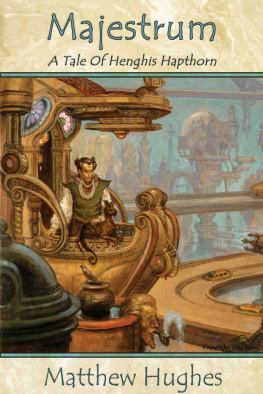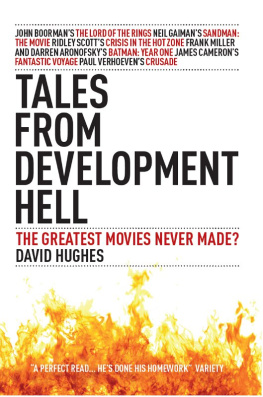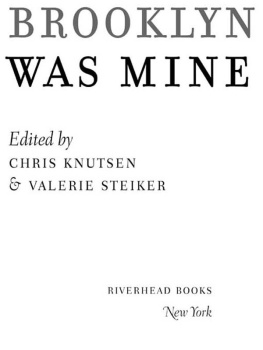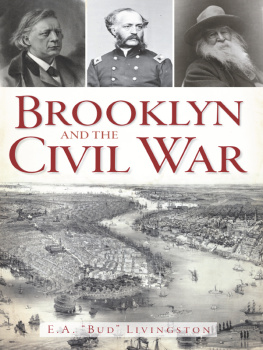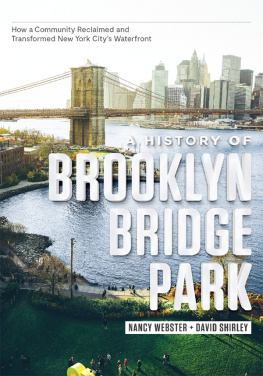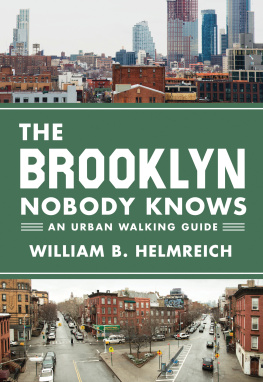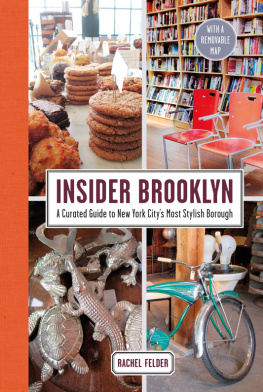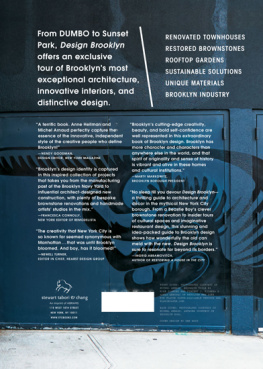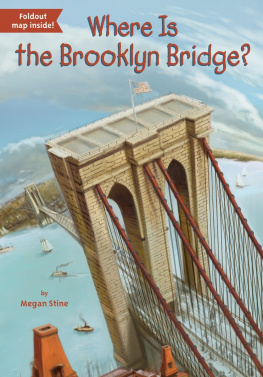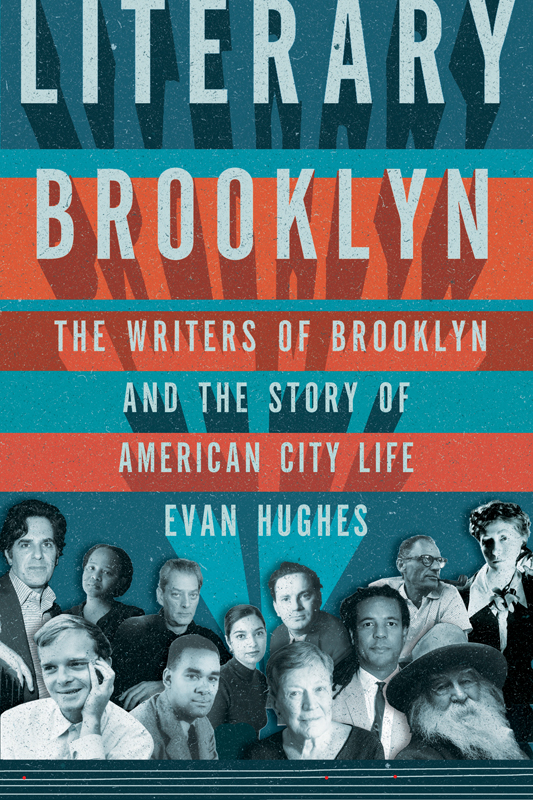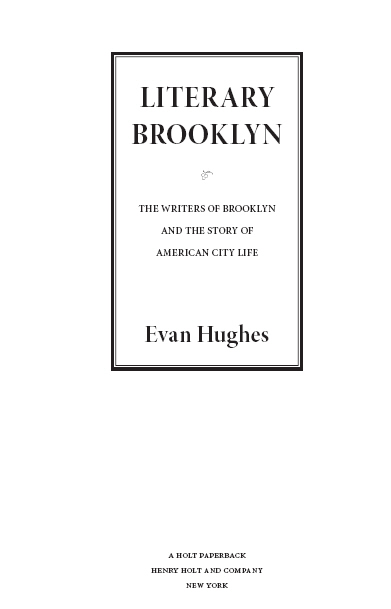
For my father,
Guy D. Hughes,
19342009
Contents
WALT WHITMAN
HENRY MILLER
HART CRANE AND MARIANNE MOORE
THOMAS WOLFE
DANIEL FUCHS, BERNARD MALAMUD, ALFRED KAZIN
RICHARD WRIGHT
FEBRUARY HOUSE AND TRUMAN CAPOTE
WILLIAM STYRON AND SOPHIES CHOICE
NORMAN MAILER
ARTHUR MILLER, PETE HAMILL, HUBERT SELBY JR.
JONATHAN LETHEM, L. J. DAVIS, PAULA FOX
PAUL AUSTER, A RENAISSANCE IN FORT GREENE
THE BROOKLYN OF TODAY


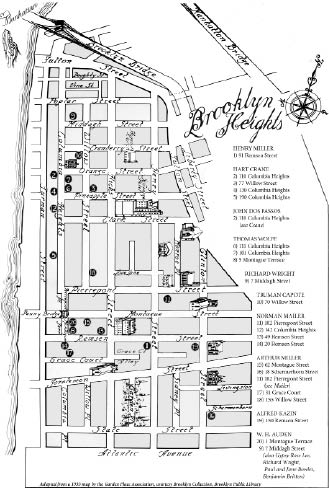
Introduction
In 1965, when the writer L. J. Davis bought an eleven-room Brooklyn town house for $17,500, the neighbors laughed at him for overpaying. On the surrounding streets of his neighborhood, Boerum Hill, loose garbage blew down the sidewalk, the trees were stripped bare, and walking home meant carefully planning the least threatening route. Stately brownstones built in the nineteenth century had been converted into crumbling boardinghouses paved with mattresses, with up to thirty people living in squalor in a space designed for one family. A neighbor slept in a tent inside his house because large chunks of the roof had caved in. Daviss literary agent told him that Brooklyn was not a suitable place for an author to live.
Davis sold his house a few years ago for roughly one hundred times what he paid to buy it. A phenomenal decrease in crime and a remaking of Brooklyns image over the last two decades have turned neighborhoods like Boerum Hill into centers of cultural vibrancy. In recent years writers have made the move to Brooklyn in droves, and the borough has drawn new independent bookstores, a prominent literary festival, and a steady flow of readings and book parties. Brooklyns bookish scene has become the talk of the literary world. Theres a good chance a given American author lives in New York City, as always. But now theres an even better chance a New York City author is based in the borough of Brooklyn.
This migration from Manhattan to Brooklyn represents something of a reversal in the fraught historical relationship between the two boroughs. On the one hand, more people live in Brooklyn than in San Francisco, Washington, D.C., Boston, and Miami put together . Its population tops Manhattans not by a little but by over 900,000. But when the world pictures New York City, it pictures the skyline of Manhattan.
Back when Brooklyn led the movement to build the Brooklyn Bridge, it was a thriving independent city, and the architectural marvel instantly became a source of hometown pride when it opened in 1883. But in a sense that first bridge to Manhattan spelled doom for Brooklyns autonomy. Fifteen years later Brooklyn was swallowed into the enormous City of New York despite much reluctance and even outrage. Until then the third-largest city in the country, Brooklyn became a mere outer borough, subject to the control of New Yorks elite. The consolidation proposal passed by only 277 votes in Brooklyn, where some residents hung black crepe in their windows in mourning. Consolidation conferred many benefits on Brooklyn, but the borough president still refers to it, only half in jest, as the Great Mistake.
From early on, Brooklyn has grown up in the long shadow of its more glamorous and vertical neighbor. Manhattan has had the strongest retail trade, the grandest museums, the Ivy League, the titans of industry, the tourists, Wall Street, Broadway, the skyscrapers that symbolized power and achievement. There isnt much it hasnt had. Brooklyn has meanwhile nursed a certain grudge over its subordinate position, especially when some Manhattanites have seemed to view Brooklyn, in Ralph Foster Welds words, as somewhere remote as Tibet, a vague and unreal land, possibly nonexistent. Even today, unlike those major U.S. cities that it dwarfs in size, Brooklyn has had no major newspaper and no major sports team for over fifty years, and indeed no independent government for twice that long. For commuters, it is more a place you start from than a place you end up.
Until recently, too, the focus on Manhattan as an intellectual beacon left little room to imagine Brooklyn as a cosmopolitan or sophisticated place, for all its size and diversity. Most of the associations that Brooklyn did call to mindConey Island, the Dodgers, stickball, the egg creamhad little to do with arts and letters. In fact, the Brooklyn guy in the movies always seemed to be a bit of a dim bulb with a mongrel accentsalt of the earth, good for a laugh. If you were looking for writers, you were supposed to go to Greenwich Village.
But Brooklyn has always offered a perspective that Manhattan hasnt. Saul Steinbergs The View from 9th Avenue, a 1976 cover illustration for the New Yorker , famously captured Manhattans special brand of provincialism: everything about Manhattans west side looms large, consuming most of the picture, while the rest of the country and the world is barely worthy of a haphazard sketch. Brooklyn shares some of the same viewpoint, being after all a part of New York City. But the writers of Brooklyn have also shown that there is more to the American story than the behemoth next door.
There is no Brooklyn school of literature and there never has been. We shouldnt mistake a massive place for an aesthetic camp. One experience Brooklyns writers have shared, however, is living just outside the colossal, churning center of the metropolisacross the river from what is still often referred to as the city. Some have used all their might to make the escape from impoverished Brooklyn neighborhoods to the urbane quarters of Manhattanthe crossing Norman Podhoretz called one of the longest journeys in the worldbut in their work they have often returned to the scene of their early Brooklyn struggles. Other writers have chosen Brooklyn as an escape from the commercial clamor of Manhattan, seeking a retreat where the rent is lower, the pulse runs slower, and the buildings dont crowd out the sky. For this group, too, the distance between the boroughs has felt greater than in actual fact. In either case, writers have tended to find more meaning and inspiration in Brooklyn itself than they might have expected.
Part of Brooklyns richness as a site of the literary imagination, I think, lies in the very fact that it is not only a truly distinct place from Manhattan but a less exceptional one, in the strict sense of the word. More human in scale, less visually extravagant, not as wealthy or stylish, more suspicious of what is fashionable or famous, slower to hunger for the newBrooklyn is more like America.
As such, for centuries Brooklyn has provided a revealing window onto the broader history of American urban life. And the boroughs writers, casting their eyes on the same streets decades apart, have brought that history to life in vivid colors. In Walt Whitmans nineteenth-century Brooklyn, we see a pastoral scene rapidly supplanted by the wild, unchecked glories and afflictions of the frantically urbanizing North and the intense polarization of the country that led to the Civil War. In Henry Millers reflections on his childhood, we see a jumble of European immigrant groups at the turn of the twentieth century all trying to gain a foothold on the same turf. In Hart Crane we find the fallout of the Great War giving way to 1920s prosperity and a more hopeful kind of modernity. In the narratives of Daniel Fuchs, Alfred Kazin, and Bernard Malamud, the sons of poor Jewish immigrants, we come to grips with the depths of the Depression, when families like theirs grasped at the lowest rungs of society. Thomas Wolfe, too, turned his attention to the Brooklyn streets to capture the grim 1930s. The southerner had gone there to hole up alone, but he found instead that while young men were writing manifestos in the higher magazines of Manhattan, the weather of mans life was soaking in on me in those years in Brooklyn. The high-society crowd in Manhattan who thought their fingers were on the American pulse, he felt, were actually missing everything.



